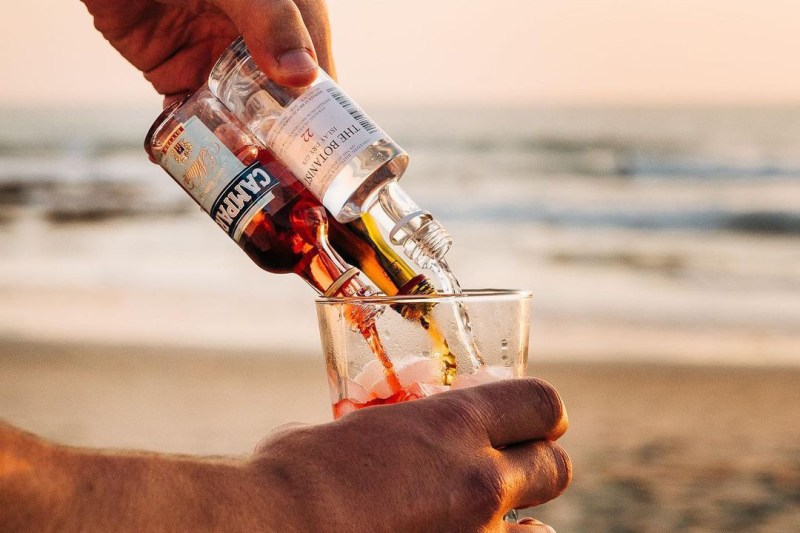
In a year when socializing has gone digital and drinking has become DIY, innovation has been a necessity in the cocktail game. Bartenders have been forced to concoct creative solutions from canned cocktails to virtual happy hours to remain solvent, and patrons have been left to entertain themselves with flask tipples in front of the TV. We all miss the camaraderie and togetherness that came with drinking with strangers, and with bars either closed or trapped behind plexiglass, any solution that brings people together over drinks is welcome right now. Which is why you should get your hands on a Togroni.
The Togroni is exactly what you think it is, but probably not the way you think. It’s a to-go Negroni made by securing nips of gin, Campari, and sweet vermouth together with packing tape and, when the time is right, pouring them in unison into a glass. It’s a simple and satisfying process that proves old drinks can definitely learn new tricks. But it isn’t just a drink, it’s an entire movement.
On Instagram, @togroni self-identifies as “HANDROLLED TRIPLE-BARREL NEGRONIS.” That all-caps enthusiasm more or less sums up the cocktail’s vibe, which is to get poppin’-bottles-in-the-club levels of excited about three nips crudely taped together and poured over ice. The page overflows with videos of drinkers gleefully pouring and boomerang-ing Togronis in all manner of places, from gardens to gondolas to straight-down-their-gullets. It’s such a simple idea that you’re probably wondering why nobody thought of it sooner, but necessity is the mother of invention, and lockdown has made us all into boozy McGyvers.
Responsible for this miniaturized madness is Boston wine consultant and Negroni-enthusiast Nick O’Connell, who dreamed up the idea when he discovered that everything he needed to make his favorite cocktail was sold in 1.69oz servings. “When I found out that all the key ingredients came in nip sizes, I got inspired.” O’Connell said. He reached for some packing tape and experimented with different gins and vermouths, finally landing on The Botanist Islay Dry Gin for its robust flavor profile and Carpano Antica’s velvety, classic sweet vermouth. “When I realized it made the perfect pour, I knew I was onto something.”
View this post on Instagram
Coworkers laughed when he first began winding packing tape around mini bottles and putting them by the register, but in the first week Nick sold 100 Togronis, and in the months since the drink’s inception he says he’s received shipping inquiries from all over the world. “Out in Australia, people had trouble finding the 50mL sizes, so they even went to the length to buy The Botanist, Campari, and Antica and pour it into travel-sized shampoo bottles to make a Togroni! I think that really speaks to how large this movement is growing.”
And it is growing. Nick has a patent in the works, and he has reached out to Campari, hoping to partner with the bitters behemoth in what he describes as an obvious alley-oop for their aperitif brand. But business aside, Nick says his favorite part of the whole movement is seeing how creative people have gotten with their Togronis: “Slow-motion videos, high resolution action shots and, most of all, people enjoying Negronis in places they would most likely never be available… much more than a to-go Negroni,” Nick says, “it is an invitation for the consumer to do something out of the ordinary.”
And right now, out of the ordinary means anything that involves having fun with people you’ve never met. “With the concept of indoor dining (and drinking) still uncertain,” says O’Connell, “the Togroni is the ultimate solution for so many. While I believe the current state of social distanced drinking has contributed to the popularity of the Togroni, I think the portable cocktail trend is here to stay.” As much as the drink itself, the Togroni’s sense of virtual camaraderie seems to be driving this trend, proving that you can take the silly drunk people out of the bar, but you can’t take the desire to get silly and drunk with strangers out of the people.
As for what’s next for the Togroni, Nick is optimistic. “There are plenty of ready-to-drink cocktails on the market, but none in this format until now. The process is as fun as it is delicious and for that reason, I believe the future is bright.”



